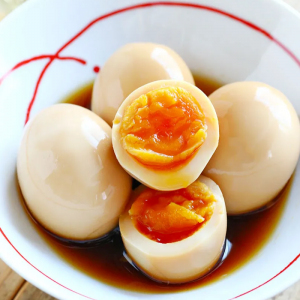Nitamago or Ajitsuke Tamago (Ajitama)
Ajitsuke Tamago, also known as Ajitama (味玉), literally translates to "seasoned eggs" in Japanese. These marinated eggs are a classic accompaniment in Japanese cuisine, especially in the traditional ramen dish. They are renowned for their delicate texture and perfectly balanced umami flavor, brought by the marinade.
 Garanties sécurité
Garanties sécurité
(à modifier dans le module "Réassurance")
 Politique de livraison
Politique de livraison
(à modifier dans le module "Réassurance")
 Politique retours
Politique retours
(à modifier dans le module "Réassurance")
The Nitamago or Ajitsuke Tamago (味付玉子), also known as Ajitama, is a hard-boiled egg marinated in a flavorful sauce and mainly used in ramen, but also in other Japanese dishes. The idea behind this egg is to combine perfectly cooked eggs with a savory marinade to create a perfect balance of texture and taste.
History The exact origins of nitamago eggs are somewhat unclear, but it is known that they have been part of Japanese culinary tradition for several centuries, although they gained particular popularity in the 20th century with the rise of ramen as a popular dish in Japan. Ramen itself was introduced to Japan in the 1910s from China and was modified over time to suit Japanese tastes.
The marinated egg is a classic topping for ramen, adding a creamy and savory texture that complements the richness of the broth. The egg itself, perfectly cooked with a runny yolk, contrasts with the salty and sweet marinade. While the phenomenon of marinated eggs has existed in Japan for a long time, their popularity in ramen dates back to the 1950s-1960s, when the dish became widely appreciated across the country.
The First Writings The use of eggs in Japanese cuisine dates back centuries, but the specific recipe for ajitsuke tamago began to appear in cookbooks in the 1950s-1970s, when ramen started to gain popularity in Japan after the war. Early ramen recipes didn’t always include marinated eggs, but as ramen diversified, the addition of the marinated egg became common. Variations of the marinade evolved over time, but the use of soy sauce, mirin, and sake was predominant from the earliest writings.
Egg in Japanese Culture Beyond its role in ramen, the marinated egg is a highly appreciated food in Japan, often served with salads, rice bowls, or bento. The marinated egg is also a traditional addition at festivals and special events. Ajitama are a true representation of Japanese cuisine: a delicate balance between sweet, salty, and umami, with an attractive visual appeal.
Today, nitamago eggs are a must-have in quality ramen, and their recipe has been adapted in many restaurants worldwide, making them a culinary symbol of modern Japan. Variations of marinades can be found, but the basic principle remains the marination of eggs in a sweet and umami soy sauce.
Popular Variants of Nitamago or Ajitsuke Tamago (Marinated Egg) There are several variants of nitamago or ajitsuke tamago (marinated egg) based on personal preferences or regional influences. Here are some examples of popular variants:
味噌漬け玉子 (Miso Marinade)
Some recipes use miso in the marinade to add extra depth of flavor. Miso brings a more intense umami touch and a fermented flavor that contrasts nicely with the sweetness of mirin and the saltiness of soy sauce.
Additional ingredients: miso paste (white or red), sometimes a little rice vinegar to balance the flavors.
辛い玉子 (Spicy Marinade)
For those who enjoy spicy flavors, a spicy marinade can be made by adding chili peppers or chili paste (like spicy miso paste or rayu – chili oil) to the base of the marinade. This adds heat to the egg while keeping the sweet-salty balance.
Additional ingredients: chili paste, dried chili flakes, rayu (chili oil), or even sambal oelek.
柚子玉子 (Yuzu Marinade)
Yuzu, a Japanese citrus, can be used in the marinade to add a citrusy note. This makes the egg slightly fresher and more aromatic, with a pleasant tang.
Additional ingredients: yuzu juice, yuzu zest, or even yuzu kosho (a paste of yuzu and chili) for a spicier and more acidic flavor.
ごま玉子 (Sesame Marinade)
In some versions, sesame oil or toasted sesame seeds can be added to bring a nutty taste and crunchy texture.
Additional ingredients: sesame oil, toasted sesame seeds (white or black), light soy sauce.
紫蘇玉子 (Shiso Marinade)
Shiso, a Japanese aromatic herb with a flavor between mint and basil, is sometimes added to the marinade for an herbal and slightly pungent taste. This variant is less common but offers a fresh and original touch.
Additional ingredients: shiso leaves, sometimes cut into thin strips and added to the marinade or placed around the eggs during marination.
ヴィーガン玉子 (Vegan Version)
For a vegan or gluten-free version, tamari soy sauce (wheat-free) can be used and white sugar replaced with organic cane sugar or coconut sugar. Some vegan recipes also substitute mirin with sweet rice vinegar.
Additional ingredients: tamari soy sauce, maple syrup or another natural sweetener, rice vinegar or apple cider vinegar.
昆布玉子 (Kombu Marinade)
Some variants include kombu seaweed in the marinade to add an extra umami flavor. Kombu is rich in natural monosodium glutamate and adds a subtle but highly appreciated savory dimension in Japanese cuisine.
Additional ingredients: Kombu (seaweed), sometimes also a little bonito flakes (katsuobushi) for a touch of dashi.
甘い玉子 (Sweet Marinade)
Some people like to prepare a sweeter marinade by increasing the amount of sugar or mirin in the recipe. This can be especially delicious if you use firmer boiled eggs, where the sweetness complements the egg's texture.
Additional ingredients: more brown sugar or rice syrup, sometimes with a hint of malt syrup for a more caramelized taste.
酒玉子 (Sake Marinade)
By using sake or rice wine in the marinade, some add a touch of alcohol that helps tenderize the egg while infusing unique flavors. This is a slightly more sophisticated variant and is often used in high-end ramen recipes.
Additional ingredients: sake, sometimes a little more mirin to increase the sweetness.
トリュフ玉子 (Truffle Marinade)
For a truly refined touch, some modern recipes include truffle oil or pieces of truffle to add an earthy and luxurious flavor to the egg. This can be an interesting variation for a gourmet ramen dish or an elegant appetizer.
Additional ingredients: truffle oil, grated truffle.
These variants allow you to personalize ajitsuke tamago according to your taste, whether you prefer something spicier, sweeter, or even a bit more exotic. You can experiment with these different ingredients to create unique marinated eggs suited to your culinary preferences!
Nitamago or Ajitsuke Tamago (Ajitama)
玉子煮玉子または味付玉子(味玉)
Ingredients
- 4 eggs
- 100 ml of Shoyu or Tamari soy sauce 醤油またはたまり醤油
(Shoyu 醤油: The most common Japanese soy sauce, usually slightly sweet and less salty than Chinese soy sauce. It's perfect for egg marination. Look for "koikuchi" shoyu (dark soy sauce) that has a good balance of umami and sweetness.)
(Tamari たまり: Wheat-free soy sauce, often richer in taste and slightly less salty than traditional shoyu. Suitable for gluten-free diets.) - 100 ml of mirin みりん (light amber sweet rice wine, syrupy and quite sweet, with an alcohol content usually lower than sake (11-18%).)
- 1 tablespoon of sake 酒
- 50 ml of water
- 1 tablespoon of organic brown sugar
(Brown sugar, or unrefined cane sugar, is less processed than white sugar and retains some of its natural molasses. Rich in minerals like calcium, iron, potassium, and magnesium, it also contains B vitamins. Its molasses gives it a richer and caramelized taste.) - 1 garlic clove
- 1 cm of ginger root
Instructions
The day before:
- Put all the liquid ingredients in a saucepan.
- Add the sugar, peeled and diced garlic, and ginger.
- When the mixture starts to boil and the sugar is dissolved, turn off the heat.
- Let it cool and infuse overnight.
Egg Cooking:
- In a saucepan, bring water to a boil.
- Once the water is boiling, reduce the heat and gently add the eggs.
- Cook the eggs for 6-7 minutes for a runny yolk.
- After cooking, immediately plunge the eggs into a bowl of ice-cold water to stop the cooking process.
- Let them cool for about 5-10 minutes.
- Once cooled, gently peel the eggs under running water to avoid breaking them.
Marinating the Eggs:
- Place the peeled eggs in an airtight container and pour the marinade over the eggs.
- Ensure the eggs are fully submerged in the marinade. You can use a small bowl to weigh them down if needed.
- Close the container and marinate in the fridge for at least 4 hours, preferably overnight for the best flavor.
Serving:
- Once marinated, remove the eggs from the marinade and cut them in half.
- Serve them with ramen, in salads, or simply as a side dish.
Tips:
- Storage: Ajitsuke Tamago keeps well in the refrigerator for about a week.
- Variations: You can adjust the marinade based on your preferences, such as adding more mirin or soy sauce.
Enjoy your meal! These marinated eggs will add a delicious touch to your ramen or other dishes.


